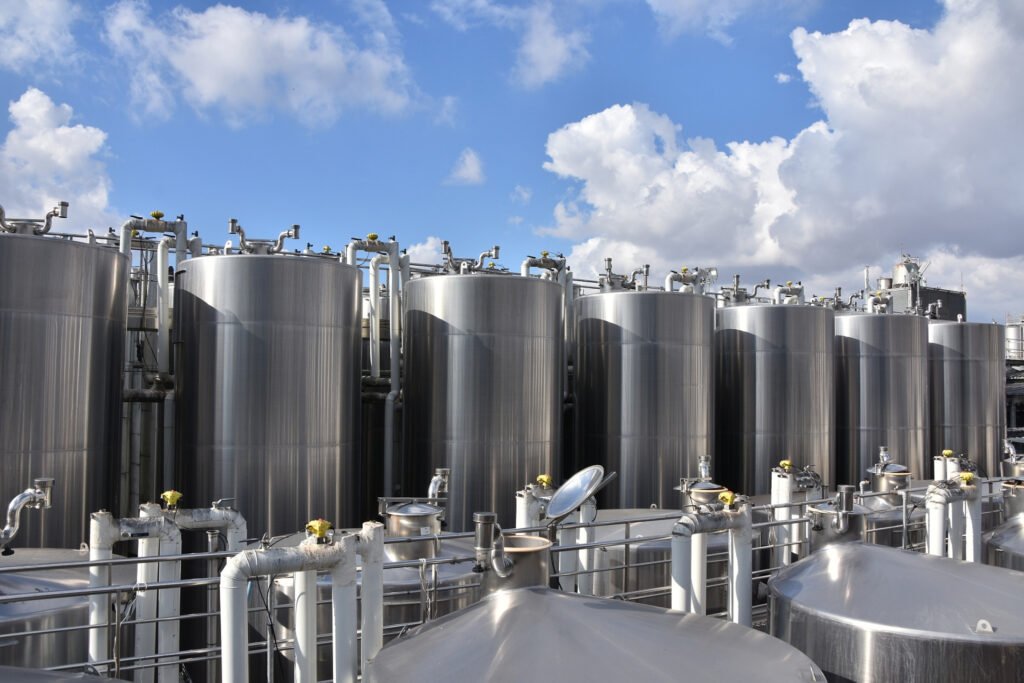
Alcohol production is an energy-intensive industrial process, which mainly includes fermentation, distillation, concentration and drying. These links not only require a large amount of heat energy, but also produce low-grade waste heat such as waste water and waste steam. High-temperature heat pumps (HTHP) can significantly improve energy efficiency, reduce production costs, and reduce carbon emissions by efficiently recovering and utilizing this waste heat, heating it up and reusing it in the production process.
Main thermal processes used in alcohol production
- Fermentation temperature control
- Process: Starchy or sugary raw materials are fermented by yeast to produce alcohol. A stable temperature is required during the fermentation process.
- Temperature requirements: Generally controlled at 28~32°C.
- Waste heat source: fermentation tank cooling water (temperature 30~35°C).
- Distillation
- Process: Use steam to heat the fermentation broth and separate the alcohol through multi-stage distillation.
- Temperature requirements: Typically steam at 110~140°C is required.
- Source of waste heat: Waste heat generated by condensation in distillation equipment (temperature 60~80°C).
- Concentrate
- Process: Further concentrate the alcoholic solution to high purity.
- Temperature requirement: 90~120°C thermal energy is required.
- Source of waste heat: Concentrated condensation waste heat and hot water.
- Drying
- Process: The distiller’s grains are dried to reduce moisture content and facilitate subsequent use.
- Temperature requirements: Dry air typically requires 100~150°C.
- Source of waste heat: hot gas discharged from drying equipment (temperature 60~90°C).
Application scenarios of high temperature heat pumps
- Fermentation waste heat recovery
The high-temperature heat pump can recover the heat in the fermentation tank cooling water (temperature 30~35°C) and raise it to 90°C or higher for use in the distillation or concentration process.
- Case: Recover cooling water heat in the fermentation process, reduce boiler fuel demand, and improve system energy efficiency.
- Reuse of distillation waste heat
The condensation waste heat (temperature 60~80°C) during the distillation process is usually directly discharged. A high-temperature heat pump can raise its temperature to 110~140°C, which can be used again to heat the distillation tower.
- Effect: Steam demand is significantly reduced and energy recycling is optimized.
- Dry exhaust gas heat recovery
The large amount of waste heat (temperature 60~90°C) emitted by drying equipment (such as distiller’s grain dryer) can be recovered through high-temperature heat pumps, and the heat can be used for dry air heating or other links.
- Case: The drying exhaust gas temperature is increased from 70°C to 120°C and re-supplied to the dryer to save external heat sources.
- Integrated thermal energy management
High-temperature heat pumps can integrate waste heat resources from all aspects of alcohol production, provide the required heat energy for different process sections through centralized processing, and build an efficient thermal energy closed-loop system.
- Effect: Realize cascade utilization of waste heat, improve energy utilization efficiency, and reduce overall energy consumption.
Economic and environmental benefits
- Save energy costs
- High-temperature heat pumps use waste heat to provide the required thermal energy, reducing the need for coal, gas or electric heating.
- The system efficiency (COP) can reach 3~5, which is significantly more energy-saving than traditional boilers.
- Reduce carbon emissions
- Reduce the use of fossil fuels, reduce carbon dioxide and pollutant emissions, and help companies achieve carbon peak and carbon neutrality goals.
- Improve production efficiency
- The high-temperature heat pump heat source is stable and controllable, and can meet the strict temperature requirements of various alcohol production processes to ensure product quality.
- Reduce maintenance costs
- Compared with traditional boilers, high-temperature heat pumps have low operation and maintenance costs, long lifespan, and are more economical for long-term operation.
Case study
Background data:
- An alcohol factory processes 500 tons of fermentation broth per day and needs to provide 120°C heat energy for the distillation process.
- The temperature of the waste heat from distillation and condensation is about 70°C, and the waste heat amount is about 3,000 kW per hour.
- Use high-temperature heat pumps to replace part of the boiler heat supply.
Energy consumption calculation:

- Traditional boiler method:
- Distillation requires heat .
- Boiler efficiency is about 85%, actual energy requirement .
- High temperature heat pump method:
- Recovering waste heat , heat pump COP is assumed to be 4.
- Power consumption .
Economic benefits:

- Coal-fired boiler cost (based on coal price 0.8 yuan/kWh): .
- High-temperature heat pump cost (based on electricity price 1 yuan/kWh): .
Cost savings:

The hourly cost savings is , the daily operation is 24 hours, and the annual operation is 300 days. The annual cost savings is approximately:

Carbon reduction:
Coal burning reduction amount , calculated based on the coal emission coefficient of 0.7kg CO₂/kWh, the annual emission reduction amount is:

in conclusion
The application of high-temperature heat pumps in alcohol production can significantly reduce energy costs and carbon emissions by recovering and utilizing waste heat from distillation, drying and other processes. Compared with traditional coal-fired boilers, high-temperature heat pumps have the advantages of high efficiency, low pollution, and low operating costs. They are an ideal solution for alcohol production enterprises to achieve energy conservation and emission reduction goals.

